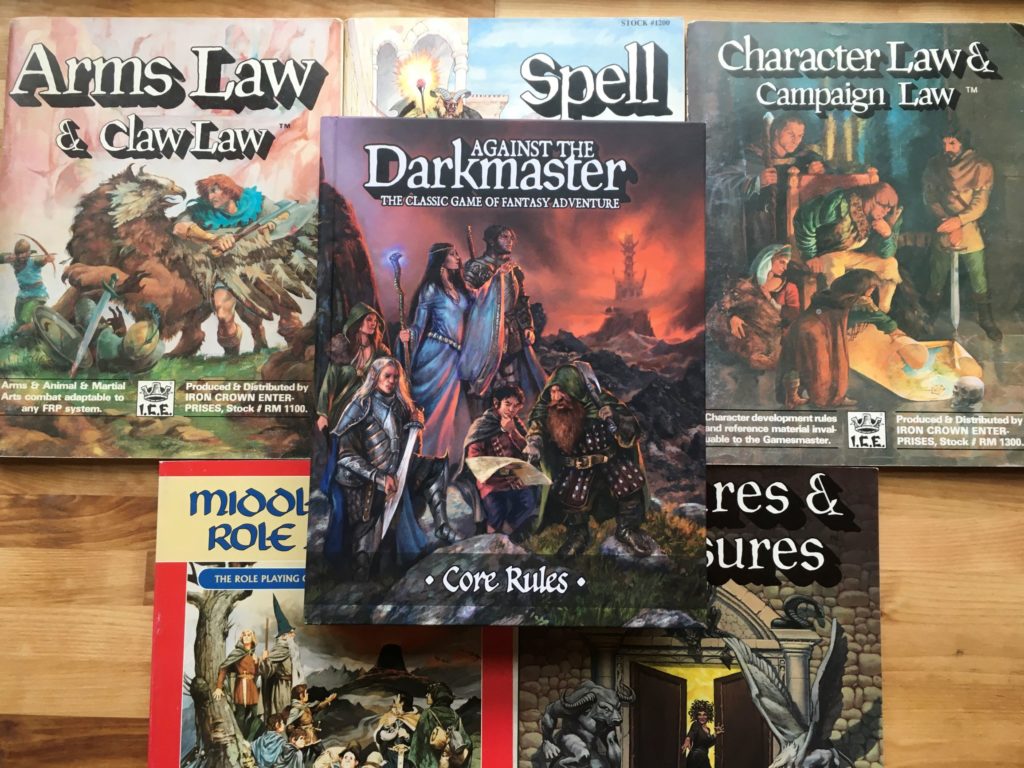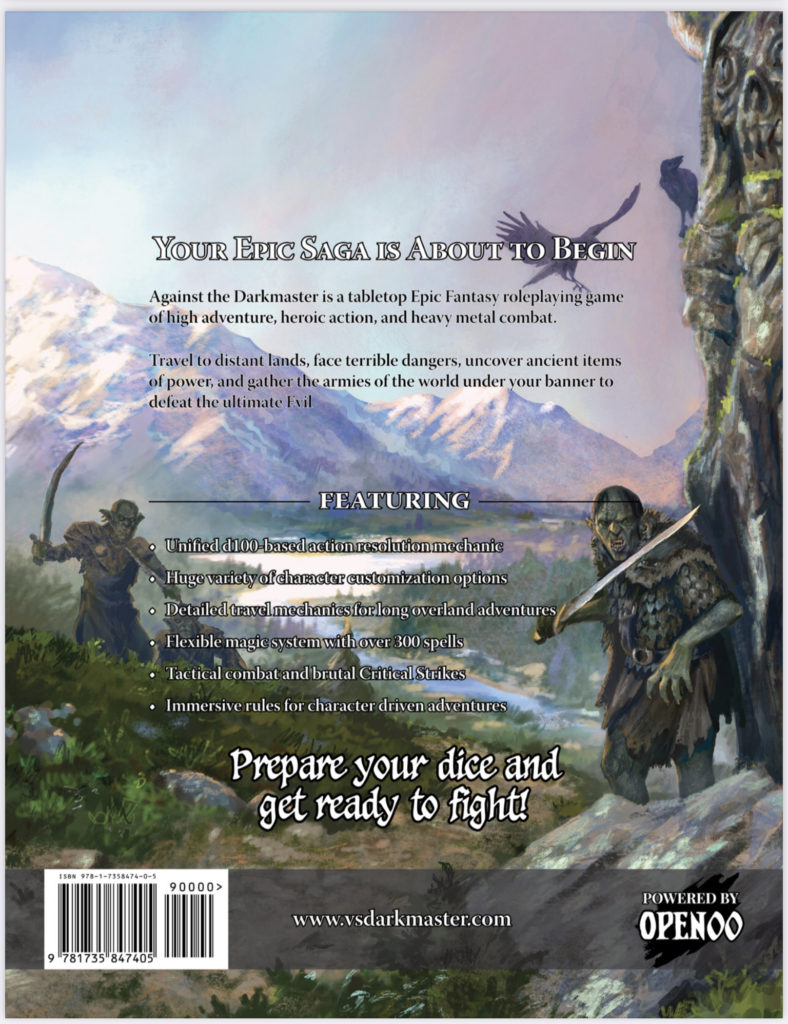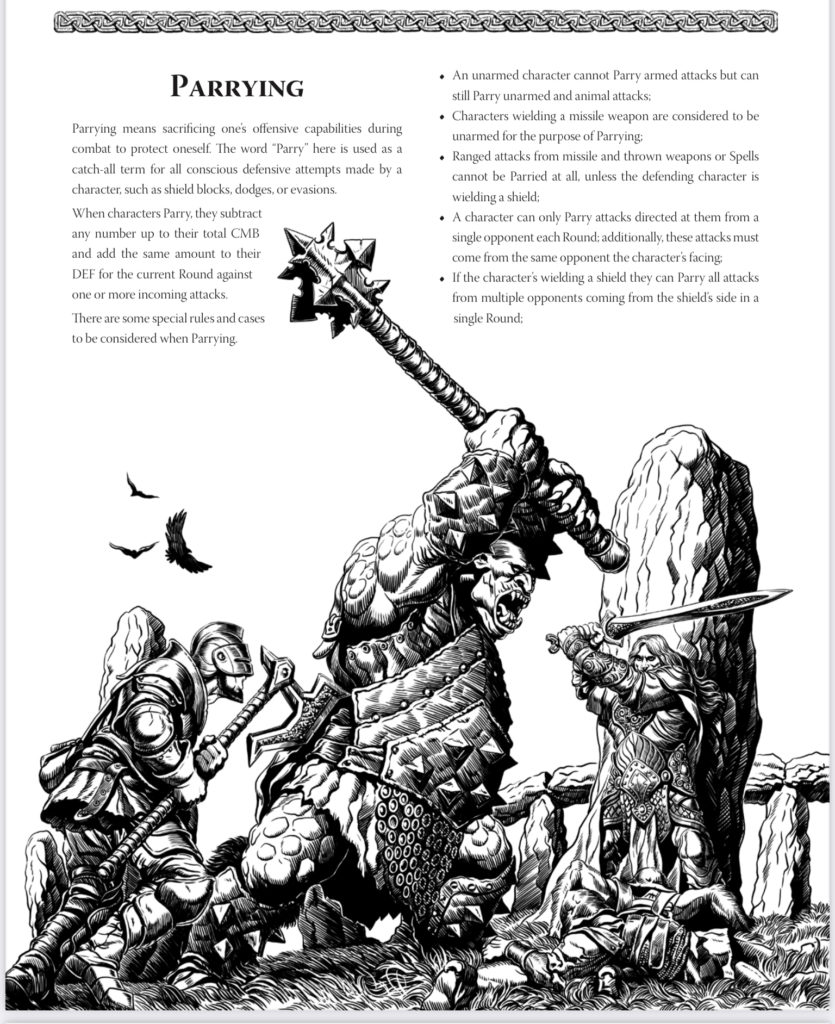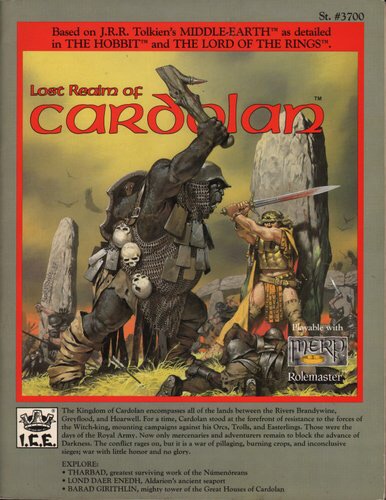Against the Darkmaster Brings Me Home

My nostalgic roleplaying game (rpg) is Middle-Earth Role Playing (MERP). That’s not a good one to bring to a table of what I term “casual” gamers. Casual gamers are the kinds who say, “Tell me what dice to roll?” MERP requires a level of energy and investment that leaks away while the GM performs all the calculations and looks up all the results on various tables. As one of my gamers tellingly noted, a few years ago when I was struggling to run it for a passive group, “Gabe’s apparently playing his own private game over there as we sit here waiting patiently for results.”
I’m not blaming the game, of course. This is the unavoidable result of this kind of game coupled with certain players. But I didn’t give up on this game until the player characters (PCs) randomly encountered a Wyvern. “Oh, man,” I chuckled, “this is going to be dangerous for you guys.” Well, it wasn’t. A lucky first hit Stunned my monster. Whether the effect lasted for one Round or eight really didn’t matter, because those PCs circled it and protracted that effect by wailing on it, as if they were those guys in Office Space, surrounding and battering at an office copier.
This is what we call being stun-locked, a known “problem” in Rolemaster systems. When it happened in my MERP group, I told my players, “I don’t think I want to play this anymore.”
Lest anyone misunderstand me, there’s nothing wrong with a mechanic that stun-locks a character. In fact, Against the Darkmaster (VsD), the game I’m about to lovingly review, doesn’t entirely “fix” this problem, if it is indeed a “problem,” but it certainly mitigates the effect. My point is that, with MERP and my local group, my sense of entertainment decreased as we procedurally rolled the attack of one character after another, checked the results to tables, then ticked off the damage from a sack of monster hit points and noted the accruing penalties to activities this poor beast never would be able to use anyway. That particular encounter had all the excitement of (to again cite the analogy) watching office workers beat on a defenseless copier. Actually, that latter is a bit more interesting.
Anyway, I lied. I continued to play MERP, because that’s when I somehow heard of Against the Darkmaster, a “retroclone” (though it’s not) of MERP, at that time in the play testing stage. I started running the test materials, then the QuickStart, for my home group. We were so involved, apparently, and my reports were so frequent, that the VsD designers put our names prominently on the front matter of the now available Core Rules.

Some games, I suspect, have play tests in name only. It’s a means by which to get one’s brand out there into the community and to inculcate a consumer base. I suspected this of VsD — and it did do this — but I also saw, over multiple playtest rules, then QuickStart iterations, the game change. In other words, for other prospective systems, the play test serves mostly as an exercise in publicity. But, with VsD, it had relevant, qualitative purpose. I saw the Ranger Vocation get removed, then the Champion get introduced, an overwhelming menu of situational combat modifiers got straight up excised, weapons received tidy Qualities, a number of confusing textual components were clarified and expanded. In short, the play test functioned, and the game is truly better for it.
The process noted above is just one reason why VsD is not the retroclone for which so many seem to mistake it. A true retroclone aims to be a faithful reproduction of an earlier game. Usually, for copyright purposes, a retroclone can’t be a precise reproduction. The textual content needs to be rewritten. Also, the designers usually can’t resist making a few rules changes, clarifying some things, ignoring others, intruding house rules that had become fairly common practice or of original design. But a retroclone usually aims to be a system that can be used right alongside all its predecessor’s publications.
This is not true for VsD. It’s main source of inspiration is MERP. It’s also inspired by Rolemaster, which is no surprise, because MERP is a RM derivative, and many players of MERP moved from using only MERP rules to the second edition of Rolemaster, for which many of the original MERP modules actually are written. But these are not VsD’s only inspirations. VsD has made itself its own, quite different game. It takes from its RM origins an “exploding,” or “open-ended” percentile dice roll, player characters that advance in levels and skills, combat charts, and (from MERP) spell lists that go up to ten (though maybe, considering VsD’s heavy metal inspirations, which shall be mentioned soon, they should go to eleven). Then it borrows from many other games, and all of its inspirations are right there in the book, listed on its opening pages.
Instead of a retroclone, what VsD seeks to do is be the rpg of 1980s high fantasy. MERP/RM’s core mechanics are still there, because that’s part of the 1980s nostalgia: rolling big numbers on a table and hoping for an exceptional result. But the game is not localized to a Middle-earth-like world. It broadens its inspirations to include high fantasy derivatives of all kinds. The Tolkien pastiches, such as the Shannara books and The Wheel of Time series, appear most suitable for VsD tone and content, but VsD also cites A Song of Ice and Fire and The First Law Trilogy — as well as the gritty and simulationist RPG Zweihander — in its inspirations. In other words, VsD’s principle purpose is to emulate epic, Tolkienian high fantasy, but, with some modification, it also can be used to play what typically are termed “low fantasy” campaigns. The VsD Core Rules provides some advice to that end and introduces an optional Sage Vocation for PCs who, though poor at actually weaving magic, know a thing or two about it through the study of many esoteric tomes of knowledge.
I have cited a few of VsD’s inspirations. It seems prudent to embellish on those.
In its first few pages, VsD not only points to high fantasy novels, mostly of the ‘80s and ‘90s, as its antecedents for emulation, but, as already stated, lists rpgs that likewise have contributed to the game’s tone and mechanical innovations since 1987’s MERP. I do not claim that much of anything about this game is wholly “original,” but its synthesis is. In other words, it takes MERP as its foundation, drastically alters those core mechanics and character creation and development in ways that those with passing familiarity with MERP just cannot see, and incorporates thirty years of innovation in rpg design. In spite of this — or perhaps because of this — I have seen VsD’s intentions and character profoundly misunderstood. We know that rpg communities can be factious; it may be that those in the Rolemaster community of games can be exceptionally so. Some people condemn VsD for “copying” MERP, though such persons fail to perceive that VsD’s intent is to honor it. Others paradoxically accuse it of being too different from MERP, perhaps expecting it to be the true “retroclone” that it is not. Others seem to resent it for (possibly) scooping a market that has been waiting, in stasis, for a new edition of the grandfather system Rolemaster. Others simply sneer at it for being, in their view, an oversimplification of their favorite Rolemaster system. Whatever the reaction one encounters, a person may conclude that a game that is so divisive and sensational within a community must be doing something right.
It is. It would be difficult for me to address VsD’s game system without making elaborate comparisons to MERP, other antecedents, and other contemporary games. I’m afraid that would be tedious and, I believe, beyond the expectations of what I imagine to be the primary audience of this site. Anyway, all I need say should be provided on VsD’s back matter blurb.

It’s all true.
Before concluding, I’d like to address, again, the inspirations upon which I had begun to elaborate. In addition to novels and games, VsD cites movies (mostly Sword & Sorcery from the 1980s) and heavy metal music as its inspirations. Most of the movies I know. As I fire up a campaign, I have been enjoying reviewing them, and I just rewatched Krull! Metal music I never have explored to any great measure, but VsD got me hunting, and I must say that I really am enjoying Tolkien Black/Doom Metal, particularly Battlelore and Avathar — both bands are from Finland. I never would have expected myself to enjoy metal, and I actually think there is something ineffable that I now understand about VsD that just wasn’t clicking before approaching this genre of music.
I began this review by a play report of a failed MERP game for my home group, so a natural question would be how well this might work for a table of casual gamers. To be clear, it was my local group of casual gamers that underwent the early VsD play test, and it went alright, though, when the group gamed on, I introduced Swords & Wizardry (though with a hefty handful of RM innovations, including a more flexible, non-Vancian spell system). I think that VsD would work again for a home group, though, to give VsD credit, it doesn’t even attempt to present itself as an easy-to-learn “first” rpg.
Instead, the release of the full VsD Core Rules in the midst of a pandemic has driven me online, and, unsurprisingly, I have discovered people remarkably like myself — i.e., in their forties, nostalgic for MERP and the cultures of their youths, tired of the current ubiquity of Dungeons & Dragons (D&D) 5e — who are adding startling creativity and energy to the beginning of our campaign. This, admittedly, has less to do, specifically, with VsD, and more to do with the changing nature of our discourse communities. A global internet network now connects us to people who are profoundly like us, be they anywhere in the world. The only things that still conspire to prevent us from fully immersing in our long and rich campaigns are work schedules and various time zones.
Lost Realm of Cardolan (ICE 1987). Cover by Angus McBride
All this love leaves little room for criticism, but I have one. Unfortunately, VsD meets the RPG industry standard for numerous textual typos and errors. And a last comment is less a criticism as it is an observation: the single hard bound copy of Against the Darkmaster: Core Rules is the largest and heaviest of the RPGs I own. Seriously, it is wider and weighs more than my next most-expansive rulebook, which is Jeffrey Talanian’s Astonishing Swordsmen & Sorcerers of Hyperborea 2e. The only RPG book I own that is larger than either is Pett’s campaign setting and adventures The Blight from Frog God Games. The immensity of the VsD core book is, of course, awesome. It’s also not much of a burden because, these days, most of us are gaming online. But, when we get back to an actual table, it’s going to be quite a load. For this reason, many in the VsD community have called for a lighter companion publication devoted to solely player-facing material, and it sounds like the company, Open Ended Games, is considering this request.

Many who visit this site are collectors of some sort, so I think I should say a few more things about the quality of the product. As already stated, it is a heavy, hardback book. It has a good, solid binding and thick white paper. It is illustrated throughout with black-and-white drawings that evoke the styles (not so much of other common sources of nostalgia, the illustrators of the original D&D books) of MERP’s and RM’s Angus McBride and Liz Danforth and (to look at the novels) Darrell K. Sweet and (in animated film) Ralph Bakshi.
But don’t take my word for it. Visit the official VsD site. Go to DriveThruRPG and spend nothing on a QuickStart download. Everything is worth it.
Gabe’s last article for Black Gate was A Report On Modiphius’s Robert E. Howard’s Conan: Adventures In An Age Undreamed Of.

Thanks for this. Did you ever use the HARP system, from Iron Crown, creators of Rolemaster/MERP? It’s light MERP.
Thanks, alx. Well, I’ve never played or run HARP. I own the first printing. I’ve read it, and it looks really cool! I would love to play it. The only reason why I haven’t, I suppose, is because I gapped it. My gaming life has been childhood (1987-92), early 00s (with 3e), and now, in my mid-40s, totally committed to the culture.
Also, I hope you don’t mind, but, on entirely academic grounds, I quibble about HARP being MERP-lite. To me it’s a system inspired by MERP/RM but quite different in its final formulation. Some particulars: there’s only one combat chart to hit and critical, rather than the two (attack and critical); most divergently, spells aren’t organized in lists (for me, one of RM’s more attractive features!) but instead are discrete spells that can be “warped” with the use of additional Power Points.
And that, I believe, is an excellent feature that [drumroll] VsD has added to its rules! As I stated in my review, VsD spell lists go up to ten, as with MERP. But many specific spells have the additional feature of being Warped — essentially cast at higher levels, with greater expenditure of Magic Points—for greater effects. So, VsD definitely borrowed from HARP here (HARP is listed as one of the game’s many inspirations).
I think this is a better and more innovative approach than either HARP or traditional RM. This allows VsD to keep spells unique, whereas, in RM lists, there are just “better” versions of the same spell at higher levels, while also providing some mechanism with which they can scale.
I’m a big fan of RoleMaster/MERP and this looks interesting!
Thanks for the heads up, Mr. Dybing.
My pleasure! I love this game!
Here’s their website. https://www.vsdarkmaster.com/
Here they are on Facebook. https://www.facebook.com/vsdarkmaster/
Here they are on Discord. https://discord.gg/7sCS7BBY
I had a lot of the Spacemaster materiel from Iron Crown but we only ever used it as supplements for our Traveller campaigns.